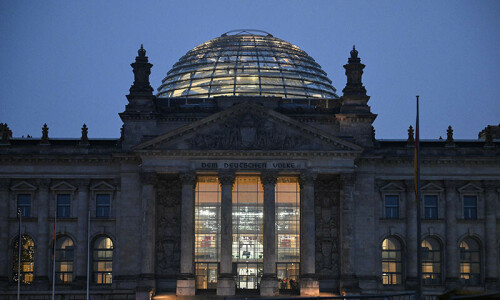In the early 1950s, William Burroughs — drug addict, homosexual and pioneering writer of what would come to be called the Beat generation — found himself in Mexico City.
On the run after accidentally shooting his wife, Joan, during a drunken game of William Tell, Burroughs relished the freedom granted by Mexico.
Here, he could indulge his sexual proclivities and drug addiction without the same risks as in the US. Out of this experience came the autobiographical novella Queer (1985). It was an account of his time in Mexico, his passion for a young expatriate man named Allerton, and their failed quest to find the hallucinogenic plant yagé.
Originally written as a sort of sequel or postscript to Junky (1953), his account of heroin addiction, Queer wasn’t published until 1985. Since then, the novella has been seen as a pioneering, if deeply problematic, account of gay desire. Queer explores the tension between personal freedom, transgression and control — themes that endured throughout Burroughs’ work.
Daniel Craig is superb in a courageous adaptation of the William Burroughs’ novel Queer
Director Luca Guadagnino’s new film adaptation stays remarkably true to the novella. Daniel Craig plays Burroughs’ alter ego, William Lee, and Drew Starkey plays Allerton. The film captures Lee’s rootless expatriate life, hanging out in bars, smoking and drinking while bitching about “the scene” with other expats. We see Lee stumble through drunken parties, picking up local boys and scoring junk, his hedonism undercut with a bleak sense of existential despair and lurking dread.
Guadagnino neatly captures the tension between bohemian freedom and loneliness, with beautifully shot and staged scenes that evoke a nascent Mexico City on the verge of modernisation — all long shadows and blue skies. The Mexicans themselves (as in Burroughs’ novella) are liminal characters, caught between sentimental and sinister stereotypes.
The weight of the movie is carried by Craig, who is superb in his portrayal of Lee. Many scenes focus on his face, sitting in bars or his room, constantly drinking, smoking and watching others, trying to gauge their sexual availability or “queerness”.
He conveys a mixture of seedy desperation, emotional neediness, defensiveness and pathos, his manner veering between nervy camp and brutal machismo — a man on the verge of psychic and physical disintegration.
Starkey is also impressive as the ambiguous Allerton. Despite identifying as a straight man, he condescends to Lee’s desires. But he also remains aloof and somewhat repelled by his occasional lover.
Queer is one of Burroughs’ most realist novels, and the movie reflects this. The stylistic, formal and thematic experimentation of Burroughs’ later works is kept in abeyance — just shown here and there in disturbing dream sequences, certain motifs (centipedes recur as a visual image) and a sense of mood.
Craig also does a good job at relaying Lee’s routines — blackly comic monologues where he seems possessed by other personas. While these performances of derangement are quite contained within Queer, from Naked Lunch (1959) onwards, they came to form the body of Burroughs’ subsequent novels.
Whereas the author was content to hint at the sexual encounters between Lee and Allerton, the movie is much more explicit. It shows moments of queer joy amid otherwise unhappy, rootless lives.
Adapting Burroughs
Like the novel, the second half of the movie follows Lee’s attempt to find yagé in the jungles of Ecuador. Yagé (more commonly known as ayahuasca) is a powerful hallucinogen used by tribal shamans. Burroughs believed the substance had telepathic properties.
In a rather beautiful sequence, two men are shown merging as the plant delivers a powerful out-of-body experience.
This transcendence cuts to the heart of Burroughs’ work, and helps explain much of the ambivalence towards queer desire and queer identity shown in both book and film. It allows Lee to become disembodied and overcome the dichotomy between the effeminate “fags” he despises and the unified, dominant male identity that also eludes him.
Guadagnino deserves credit for bringing this challenging text to the screen. Burroughs’ uncompromising vision is somewhat out of step with popular culture, presenting complicated, challenging and often deeply unsympathetic images of queerness, rather than just valorising or affirming sexual difference.
As Burroughs’ researchers such as Oliver Harris and Jamie Russell have shown, his work shows that building an identity around sexuality is another invasive form of control. In his 1985 introduction to Queer, Burroughs stated:
“I feel that I was being written in Queer… whole sections came to me as if dictated… The book is motivated and formed by an event which is never mentioned, in fact is carefully avoided: the accidental shooting death of my wife, Joan, in September 1951.”
This tragic event is alluded to twice in the film: once at a wild party, where the game is replayed with a children’s toy gun, and again in a dream sequence.
The film lingers long in the mind. Craig’s performance and the haunting visual images of Mexico and South America left me unsettled and melancholy. It is an impressive and courageous film.
The writer is a Senior Lecturer at the School of Creative and Cultural Industries at
Kingston University in the UK
Republished from The Conversation
Published in Dawn, December 22nd, 2024















































Dear visitor, the comments section is undergoing an overhaul and will return soon.